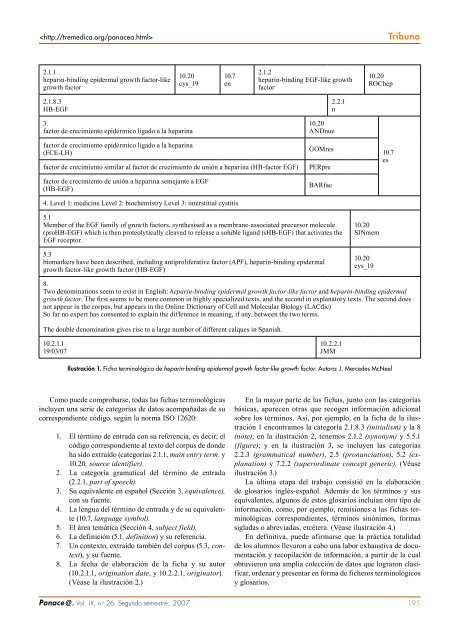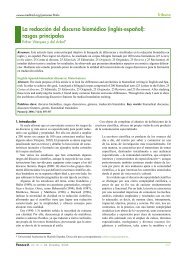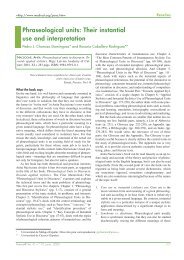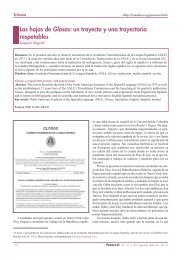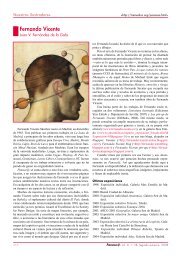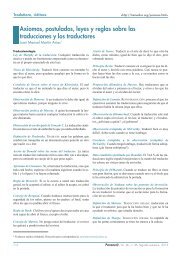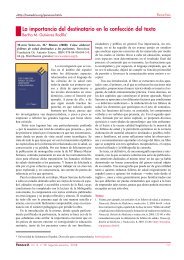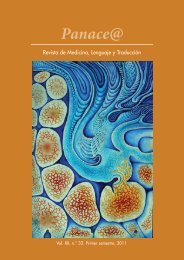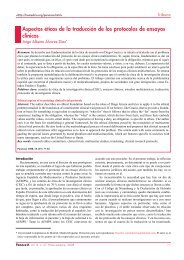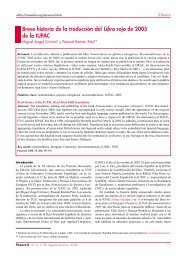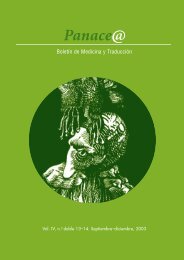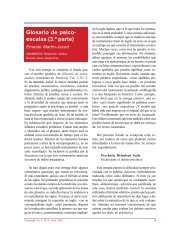Panace@ 26. Diciembre del 2007 - Tremédica
Panace@ 26. Diciembre del 2007 - Tremédica
Panace@ 26. Diciembre del 2007 - Tremédica
Create successful ePaper yourself
Turn your PDF publications into a flip-book with our unique Google optimized e-Paper software.
Tribuna<br />
2.1.1<br />
heparin-binding epidermal growth factor-like<br />
growth factor<br />
10.20<br />
cys_19<br />
10.7<br />
en<br />
2.1.2<br />
heparin-binding EGF-like growth<br />
factor<br />
10.20<br />
ROChep<br />
2.1.8.3<br />
HB-EGF<br />
2.2.1<br />
n<br />
3.<br />
factor de crecimiento epidérmico ligado a la heparina<br />
factor de crecimiento epidérmico ligado a la heparina<br />
(FCE-LH)<br />
factor de crecimiento similar al factor de crecimiento de unión a heparina (HB-factor EGF)<br />
factor de crecimiento de unión a heparina semejante a EGF<br />
(HB-EGF)<br />
4. Level 1: medicine Level 2: biochemistry Level 3: interstitial cystitis<br />
10.20<br />
ANDnue<br />
GOMres<br />
PERpre<br />
BARfac<br />
10.7<br />
es<br />
5.1<br />
Member of the EGF family of growth factors, synthesised as a membrane-associated precursor molecule<br />
(proHB-EGF) which is then proteolytically cleaved to release a soluble ligand (sHB-EGF) that activates the<br />
EGF receptor.<br />
5.3<br />
biomarkers have been described, including antiproliferative factor (APF), heparin-binding epidermal<br />
growth factor-like growth factor (HB-EGF)<br />
10.20<br />
SINmem<br />
10.20<br />
cys_19<br />
8.<br />
Two denominations seem to exist in English: heparin-binding epidermal growth factor-like factor and heparin-binding epidermal<br />
growth factor. The first seems to be more common in highly specialized texts, and the second in explanatory texts. The second does<br />
not appear in the corpus, but appears in the Online Dictionary of Cell and Molecular Biology (LACdic)<br />
So far no expert has consented to explain the difference in meaning, if any, between the two terms.<br />
The double denomination gives rise to a large number of different calques in Spanish.<br />
10.2.1.1<br />
19/03/07<br />
10.2.2.1<br />
JMM<br />
Ilustración 1. Ficha terminológica de heparin-binding epidermal growth factor-like growth factor. Autora: J. Mercedes McNeel<br />
Como puede comprobarse, todas las fichas terminológicas<br />
incluyen una serie de categorías de datos acompañadas de su<br />
correspondiente código, según la norma ISO 12620:<br />
1. El término de entrada con su referencia, es decir, el<br />
código correspondiente al texto <strong>del</strong> corpus de donde<br />
ha sido extraído (categorías 2.1.1, main entry term, y<br />
10.20, source identifier).<br />
2. La categoría gramatical <strong>del</strong> término de entrada<br />
(2.2.1, part of speech).<br />
3. Su equivalente en español (Sección 3, equivalence),<br />
con su fuente.<br />
4. La lengua <strong>del</strong> término de entrada y de su equivalente<br />
(10.7, language symbol).<br />
5. El área temática (Sección 4, subject field).<br />
6. La definición (5.1, definition) y su referencia.<br />
7. Un contexto, extraído también <strong>del</strong> corpus (5.3, context),<br />
y su fuente.<br />
8. La fecha de elaboración de la ficha y su autor<br />
(10.2.1.1, origination date, y 10.2.2.1, originator).<br />
(Véase la ilustración 2.)<br />
En la mayor parte de las fichas, junto con las categorías<br />
básicas, aparecen otras que recogen información adicional<br />
sobre los términos. Así, por ejemplo, en la ficha de la ilustración<br />
1 encontramos la categoría 2.1.8.3 (initialism) y la 8<br />
(note); en la ilustración 2, tenemos 2.1.2 (synonym) y 5.5.1<br />
(figure); y en la ilustración 3, se incluyen las categorías<br />
2.2.3 (grammatical number), 2.5 (pronunciation), 5.2 (explanation)<br />
y 7.2.2 (superordinate concept generic). (Véase<br />
ilustración 3.)<br />
La última etapa <strong>del</strong> trabajo consistió en la elaboración<br />
de glosarios inglés-español. Además de los términos y sus<br />
equivalentes, algunos de estos glosarios incluían otro tipo de<br />
información, como, por ejemplo, remisiones a las fichas terminológicas<br />
correspondientes, términos sinónimos, formas<br />
sigladas o abreviadas, etcétera. (Véase ilustración 4.)<br />
En definitiva, puede afirmarse que la práctica totalidad<br />
de los alumnos llevaron a cabo una labor exhaustiva de documentación<br />
y recopilación de información, a partir de la cual<br />
obtuvieron una amplia colección de datos que lograron clasificar,<br />
ordenar y presentar en forma de ficheros terminológicos<br />
y glosarios.<br />
<strong>Panace@</strong>. Vol. IX, n .o <strong>26.</strong> Segundo semestre, <strong>2007</strong> 195


